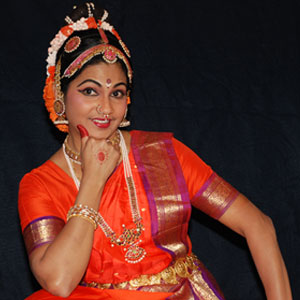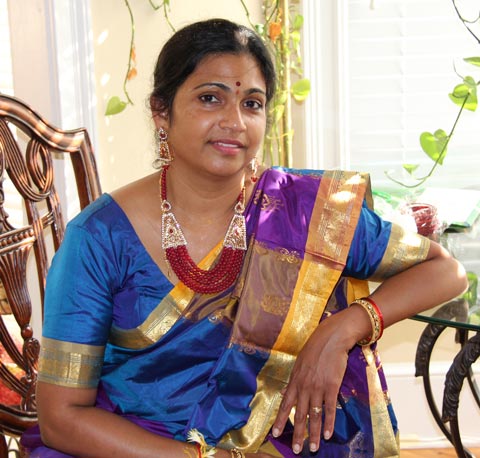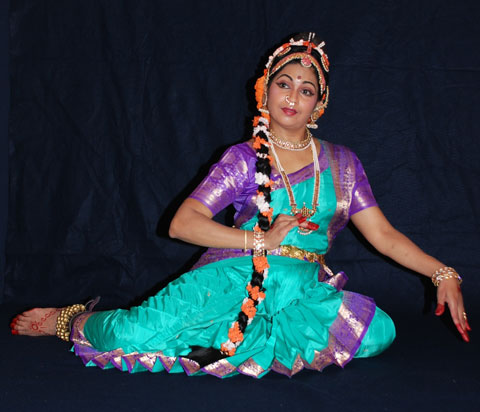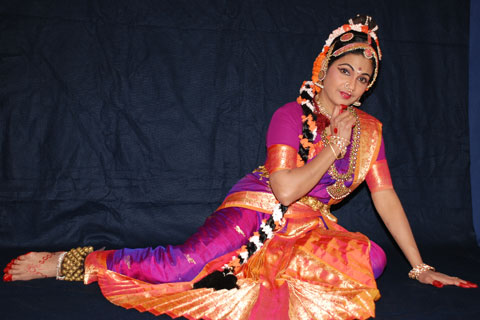Spotlight: Kuchipudi Ambassador Sasikala Penumarthi

She is certainly amongst the veterans of Indian classical dance teachers in Atlanta, but what sets her apart is her work with local institutions in promoting her art form in the mainstream.
The Atlanta Ballet’s Nutcracker is a veritable highlight of the performing arts offerings of the city.
How this cherished holiday tradition of Atlanta transformed into Swapna Vijayam (“Triumph of a Dream”) is the story of Sasikala Penumarthi’s creative spark. It was in 1998 that Penumarthi, an impassioned ambassador of Kuchipudi dance, and Maggie Holtzberg, Director of the Folklife Program of the Georgia Council for the Arts, explored the possibility of adapting Kuchipudi to Western themes. Nine years later, their efforts culminated in Swapna Vijayam, a Kuchipudi dance drama based on the story of the Nutcracker.
Performed to a packed audience in 2007, the dance drama generated rave reviews. Myrna B. Lubin, Associate Director of Young Audiences at the Woodruff Arts Center, said she was “captivated” by this version of the Nutcracker. “The costumes were beautiful and, while I don’t know much about the art form, the performers all seemed very professional. I have to say I gained a new appreciation for the scope and complexity of the choreographer’s work,” she added.
Having had rigorous training from an early age from Guru Padma Bhushan Vempati Chinna Satyam, Penumarthi is a pillar of the Kuchipudi dance form, and its most effective proponent in the Atlanta region. She is on the State roster of the Georgia Council for the Arts besides being an Artist Affiliate at Emory University. Indian classical dance is finally getting exposure in the mainstream, thanks to the dedication of proponents like Penumarthi, who have vigorously pursued the creation of academic curriculum and repertoires for young dance students. It is indeed a challenge to design and implement the methodology of instruction and evaluation for an art form several hundred years old, with no written manifests to follow.

Many students have trained and graduated with their Ranga Pravesam (first solo performance) under her tutelage. During a conversation with Khabar, Sasikala Penumarthi made it a point to mention the names of a few who enabled her dream to come true in Atlanta. They include Dr. Seshu Sarma, Dr. Mano Naidu, Dr. P. Venugopala Rao, Dr. B. K. Mohan, and a few others. “Her humility magnifies her talent. Her unwavering devotion to her guru makes her a unique student. Her nurturing of her disciples makes her the most beloved guru that I have come across in my path. Above all she is a noble soul, a truly wonderful human being,” says Dr. Seshu Sarma, who routinely accompanies Penumarthi’s live orchestra at recitals.
Excerpts from our conversation with Sasikala Penumarthi follow.
Through the Georgia Center for the Arts and Emory, you have introduced Kuchipudi to mainstream Atlanta. What has been the level of interest and are there non-Indian Kuchipudi performers in the region?
I have been with the Georgia Council for the Arts’ Governor’s Artist Roster for more than ten years and have performed at the Atlantic Station inaugural, Atlanta Dogwood Festival, Albany Arts Council, Rome Area Arts Council, Woodruff Arts Center, Tifton Fall Festival, Macon Cherry Blossom Festival, Aurora Theater in Lawrenceville, Wichita Arts Council, and Mississippi Arts Council among others. I am also an instructor and artiste with the Young Audiences of Atlanta at the Woodruff Arts Center. As part of this program, I am invited to various schools in Georgia to demonstrate Kuchipudi to students of all ages. This is very satisfying as I see a large number of children, sometimes five to six hundred, in the audience when I am showcasing Kuchipudi.
The late dear Dr. P. V. Rao, Professor Joyce Flueckiger, and I started a course at Emory in 2000 called “Dance and Embodied Knowledge in the Indian Context.” Since then, I have been alternatively teaching this course and “Introduction to Kuchipudi” as part of the Asian Studies Program and the Dance Department. These are full-semester credit courses culminating with a performance by the students, in front of other students and faculty of Emory University. This generates a lot of interest as classes get full and students are wait-listed. The liberal arts program and dance major students show tremendous interest by conducting detailed research on this art form.
Catherene Crompton, Kate Zubko, and Blair Holt are some of the students who trained under me and are continuing with Kuchipudi in other regions of the USA. I have an eight-year-old student, Trinity Sumpter, who recently started learning Kuchipudi. The program continues to draw more of them each year.
Nine generations of the ancestors of your guru, Sri Vempati Chinna Satyam, dedicated their lives to Kuchipudi. How do you feel being the ambassador and trustee for the Atlanta region of such a deep legacy?
I deeply miss my guru’s presence. Although he was in India, I always felt his presence guiding me. He would regularly ask me to commission and perform new works. I feel very blessed and honored that I learnt this dance from such a great guru. I learnt discipline, dedication, and respect for the arts under his mentorship. He worked all his life teaching, promoting, and propagating this beautiful art. I feel responsible and committed to continue imparting the knowledge gained from him, to everyone interested in learning this great art.
Tell us a little about Kuchipudi, and how it is different from Bharatnatyam, Kathakali, and other Indian classical dance forms.
Kuchipudi is one of the seven Indian classical dance forms based on the principles enunciated in Bharata Muni’s Natya Sastra, a treatise on dance that dates back to the second century B.C. While all these dance forms’ roots are based on the same treatise, local adaptations and practice over the centuries created variations between different styles. For example, Kuchipudi is drama-based, and was practiced on the streets in Kuchipudi Village in Andhra Pradesh, where the artistes unfolded stories from the Bhagavata Puranas. Kuchipudi performers use elaborate facial expressions and rhythmic footwork as they introduce various characters to describe these stories. Contributions from great gurus such as Vedantam Lakshminarayana Sastry, Tadepalli Perayya Sastry, and Padma Bhushan Guru Vempati Chinna Satyam made Kuchipudi a medium of conveying mythological and social themes to different parts of the world. Kuchipudi is pure Yakshagana, which is a combination of the Pancha Sutras, Natyam (drama), Nrittam (footwork), Nrityam (dance song) and Abhinayam (expressions), Thandavam (vigorous dance), and Lasyam (graceful dance.)
In ancient times, these dances were performed inside temples during the festival season. Eventually, the artistes took the Yakshaganas outside the temples to the masses. The dance inside the temples became Bharatanatyam and the dance outside the temples became Kuchipudi. Bharatanatyam was practiced and performed in the southern state of Tamil Nadu. Performances inside the temples were solo and presentations outside the temples were dance dramas by a group of dancers.
Kathak traces its origins from the nomadic bards of northern India known as Kathaks, who again performed in village squares and temple courtyards, telling stories from Indian mythology using intricate gestures, fast circular movements and facial expressions, portraying stories of Lord Krishna and Ashtapadis.
Kathakali originated in the southern state of Kerala and is well known for its elaborate makeup, which includes face painting, and performances that are stylized, with detailed body movements. Sometimes these performances last all night.

Has Kuchipudi, an ancient dance art form, evolved over time? Have you introduced any new variations to it?
The treatise on dance provides the alphabet that includes basic hand gestures, foot movements, nine forms of facial expression, etc., which form the basis of human expression. As I mentioned earlier, it has evolved over time and we have seven different major classical dance styles in India. Originally, stories from Indian mythology were presented but over time, social themes that conveyed a message and contributed to social transformation were showcased as well. One such theme that made waves in the early part of the twentieth century was Poornamma, which focused on the practice of child marriages prevalent during those days and advocated an end to it. We are presenting Pasidi Poornamma on June 22nd at the Gwinnett Performing Arts Center. The focus of this presentation is to celebrate the hundredth anniversary of the great poem Poornamma, which heralded the birth of modern poetry in Telugu, the fiftieth anniversary of my guru’s Kuchipudi Art Academy in Chennai, and the fifteenth anniversary of our Academy of Kuchipudi Dance, Atlanta. It is a tremendous celebration of all these benchmarks.
What did you learn from your adaptation the Nutcracker? How did the audiences receive it? Did you get any feedback from the Atlanta Ballet Company?
When I first joined the Georgia Council for the Arts roster, Maggie Holtzberg, who was the Folklife Arts Program Director at that time, visited our dance studio. When we introduced her to the Natya Sastra, she wanted to know if the traditional Kuchipudi dance form could adopt modern themes. We chose to demonstrate this concept with the adaptation of Nutcracker, a very famous Western theme performed by most ballet companies annually during the holidays. We had new lyrics written by Sri Indraganti Srikantha Sarma in Telugu, new music composed by Smt. Subhashini Krishnamurthy in the classic Carnatic style, new jathis (rhythmic syllables) by Sri Sastry Bhagavatula and new choreography composed by myself in Kuchipudi style. It was presented with a live orchestra to a full house of 1200, seated at the Robert Ferst Center for the Arts. We had invited various arts organizations including the Atlanta Ballet to be our guests and experience it. They were busy with their presentation of the Nutcracker at the Fox Theater during the same time. We received feedback from a number of people who attended the show. They thought it was unique and a variant that should be presented every year, as well.
Most Indian classical art forms were created out of reverence to the deities. What do you think is its relevance today to Indian-Americans born here? What is the reference especially for the ones who are learning Kuchipudi, not having read and/or understood the scriptures, the stories, and the language used as a basis in the choreography?
It is said that dance was created as a means to achieve happiness, pure joy, knowledge, the understanding of the value of life, and to bring peace to humanity. The language only expresses the lyrics that give the necessary emotion to the dancer, when presenting. The gestures, bodily movements, and facial expression are of primary importance to convey its meaning and hence dance is universal.
From that perspective, most Western dance forms, especially the Latin forms, seem to be more about joy and celebration, whereas Indian classical dance forms seem to be more about rigor, precision, and performance. Does that not take away from the inherent and spontaneous joy of dancing?
I believe that in every culture, dance forms have their way of expression. Each has its own technique, and perfection of this technique is what makes the dances more meaningful.
Western dances seem more fluid whereas Indian dances seem technical and have more staccato motions. Please comment.
Both Eastern and Western dance forms have fluidity and technical requirements. For example, in Natya Sastra there is a shlokam that says “Kateekarna Samayatra, Koorparaamsa Sirasthadha, Samunnatha Muraschaiva, Saushthavam Nama Tat Bhaveth.” This shlokam speaks about obtaining the right body posture, hand position, and feet position, before we begin the dance. The line “Koorparaamsa Sirasthadha” describes how the hand position is with respect to the head position. Although this description would result in choosing multiple positions, one should always make the choice based on the most graceful position, which sometimes depends on the cultures, regions, times, etc.
Of all the places you have performed around the world, which venue or performance stands out as the most memorable? Why?
In 1987, along with my guru, I was part of the group representing the Indian Council for Cultural Relations at the Art Festival in Tashkent. I played the lead role in Chandalika, a dance drama presented by my guru. This was my first presentation as Chandalika in the Nobel Laureate Rabindranath Tagore’s emotional ballet. Our interpreter came rushing backstage after the performance. Holding me he began to cry, saying, “You made me cry, you made me cry.” They later announced that I was the Performer of the Evening. Several attendees told us that they were deeply touched by the ballet. My guru, Shri Vempati Chinna Satyam, normally would not say anything, but that day he patted me on my shoulder and said I did well. This is worth a lot to me.
In 2003, another incident occurred when I was preparing to present my guru’s greatest ballet, Srinivasa Kalyanam, at the fundraiser for the Atlanta Hindu Temple. The performance was scheduled for January 4th, 2003, at the Robert Ferst Center for the Arts. My husband Ravi had gone to India to purchase costumes and jewelry for the show, which my father had helped pack. Ravi reached Atlanta with a huge box. A few days later, I received a call in the middle of the night that my father passed away. It was a big blow to me, as I had to make a very difficult decision whether to continue with the ballet preparations. I could not go to India to participate in the last rites. On the day of the performance, I felt my father’s presence in the theater and the performance was a huge success and we were sold out. I felt like my father’s blessings are always with me and helped me through these difficult times.
What is your message to current followers of classical Indian dances and those who aspire to learn them?
Learning the arts teaches culture, background, traditional values, and broadens the mind. It also gives the body and mind control, discipline, and relaxation due to mental and physical exercise. Teaching the art form gives one a lot of satisfaction as we impart this knowledge to younger generations.

Enjoyed reading Khabar magazine? Subscribe to Khabar and get a full digital copy of this Indian-American community magazine.
blog comments powered by Disqus










